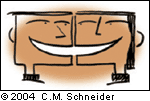
Chitchat isn’t idle. It can actually improve the doctor-patient relationship and increase your job satisfaction.
Fam Pract Manag. 2004;11(9):68

“I hear your son is heading off to college.”
“How’s your bowling team doing?”
“I missed seeing you in church on Sunday.”
“Say hi to your wife for me.”
With so much paperwork to complete, so many patients to see and so little time with each, who has time for chitchat anymore? While it may seem expendable, just a few seconds of small talk at the beginning and end of each visit can accomplish a great deal.
1. It nurtures trust. When we make small talk with our patients, we usually discover common ground, which helps us connect with one another. Acknowledging shared experiences, recounting an exciting moment from the Super Bowl, reminiscing about ice cream cones on a hot day or complaining about all the rain this year and how it is affecting our tomatoes are all modern ways of reckoning kin. These social formalities cultivate trust, especially important for physicians because of the deeply personal nature of the problems we discuss with our patients. Patients who trust us are more likely to be honest with us and follow through with our recommendations.
2. It encourages openness. When we converse with our patients, we become more human and relatable to them. Like our patients, we have spouses or significant others, aging parents and grandchildren. We too diet and exercise, wrestle with conflicting demands, and share the trials and tribulations of raising children. We understand their day-to-day joys and frustrations. Through casual conversation, we let them know that we relate to their lives. And in doing so, we give them the opportunity to open up to us. Although we don’t need to have children to treat kids, quit smoking to counsel about smoking cessation, or go through an illness to treat it, these kinds of life experiences deepen our insights and make our advice more credible.
3. It improves communication. Making small talk can be a useful way of gathering information about our patients. For example, by asking a newly widowed patient about his hobbies, we open up the opportunity for that patient to tell us about his grief in a non-threatening and open-ended way. Perhaps this patient is staying busy and coping well; or perhaps the patient is struggling each day just to get out of bed. Similarly, asking a senior citizen about her bowling group on Thursdays or the latest senior bus trip often tells us more about her arthritic knees, macular degeneration, depression and social network than our brief history and exam.
4. It improves our own satisfaction. Interacting with patients is often the most rewarding part of our jobs and the reason many of us were drawn to family medicine. We are much less likely to feel burnt out if we take a few moments to connect with our patients and be nourished by what we do. It feels good at the end of a busy day to feel that we’ve touched the lives of our patients – and that they’ve touched ours. Our own lives are enriched by these interactions.
IMPROVING YOUR SKILLS
To improve your “small talk” abilities, start by taking a good social history. This involves more than just documenting whether a patient is still smoking. Ask about his or her interests and life events, and write a brief note in the chart: “still in senior bowling league,” “youngest just went off to college,” “husband travels a lot for work,” “father in nursing home” or “just joined a health club.” These notes will help trigger your memory about a patient at the next visit.
To show you really care, send them an occasional note card. “I was sad to read in the paper that your mother died,” “Thanks for remembering me with the delicious Christmas cookies” or “Congratulations on your new grandchild.” The message can be brief; it truly is the thought that counts. This kind of correspondence adds a personal touch to your practice and is simply good social etiquette.